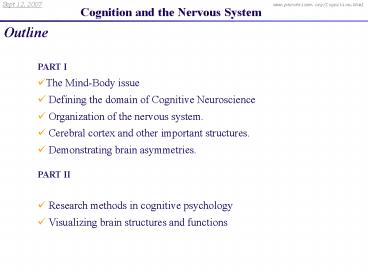The MindBody issue - PowerPoint PPT Presentation
1 / 11
Title:
The MindBody issue
Description:
Defining the domain of Cognitive Neuroscience. Organization of the nervous system. ... Cognitive neuroscience is the field of study linking the brain structures to ... – PowerPoint PPT presentation
Number of Views:24
Avg rating:3.0/5.0
Title: The MindBody issue
1
Outline
- PART I
- The Mind-Body issue
- Defining the domain of Cognitive Neuroscience
- Organization of the nervous system.
- Cerebral cortex and other important structures.
- Demonstrating brain asymmetries.
- PART II
- Research methods in cognitive psychology
- Visualizing brain structures and functions
2
The mind-body issue
The Transposed Heads A Legend of India by
Thomas Mann (1941) Sita marries a man but is
attracted by another. The two desperate men
behead themselves. Sita then prays desperately
the goddess Kali to bring them back to life. Kali
grants Sitas wish and allow her to reattach
their heads to their body. In the rush to get
them back to life, Sita switches their heads,
attaching them to the wrong bodies. Sita faces a
terrible dilemma who is who?
- Is the mind located somewhere in the body?
- If yes, what are the biological bases of our
cognitive skills? - Cognitive psychologists are interested in
answering these questions,because it is important
for many fundamental purposes to know the
physical constraints of our cognition. - Theres a long standing hypothesis that, if
there has to be a site in the body for our mind,
it is the brain. - Even though this claim stands since Hippocrates
(400 b.c.), only in the 19th century scientists
became systematically interested in localizing
cognitive functions in specific brain area.
3
Defining the domain
- Cognitive neuroscience is the field of study
linking the brain structures to cognitive
processes and, eventually, to behavior. - The founder of this branch of cognition,
Gazzaniga, claims that the nervous system is the
basis for our ability to perceive, adapt to, and
interact with the world around us.
4
The neuron
- Neurons are the cells of the brain. They are the
basic functional and structural units of the
nervous system. The neuron main task is to
receive electrical signal from other neurons and
to trasmit it, under particular conditions, to
other neurons - The main parts of the neuron are
- the Dendrites, that carry the signal in the
cell - the Soma, the cellular body, that is assumed to
integrate and process information from the
stimulated dendrites - the Axon, usually one for neuron, carries out
the processed information for the next step of
the given neural pathway
? x v
5
Neuronal communication
- Within a neuron the nature of signal
transmission is electrical. The Action Potential
propagates in the dendrites and, if it reaches a
threshold, from the body to the axon. - Basic processing in the brain is guaranteed by
communication between neurons. The functional
unit for this comunication is the synapse. - In the synapse, the pre-synatpic terminals come
very near the dendritic spine. The axons action
potential triggers the release of chemical
substances called neurotransmitters. - Once released in the synaptic junction,
transmitters thatreach specific post/synaptic
receptors will eventually determine the
so-called post-synaptic potential
(excitatory,EPSP, or inhibitory, IPSP). - Different types of neurons organized in complex
networks provide the substrate for the cognitive
modules in the brain
6
Neurotransmitters
- Neurotransmitters are chemical messengers for
transmission of information between neurons. - There are about 50 substances that the brain
uses as transmitters. They can be assigned to
three main categories - Monoamine neurotransmitters, synthesized in the
nervous system through enzymatic actions on
aminoacids (e.g., acetylcholine, dopamine,
serotonin) - Aminoacids neurotransmitters, used with no
transformation (e.g., gamma-aminobutyric acid,
GABA) - Neuropeptides, which are chains of two or
aminoacids. - The reason for such a big variety of
transmitters is that they are associated to
different actions (some are inhibitory, some
excitatory) and that their action is specific to
specific networks and/or cognitive functions
(e.g. Dopamine and Parkinson desease).
7
Organization of the nervous system
Main focus for cognition
8
Cerebral cortex and other structures supporting
cognition
- The central nervous system (CNS) is split into
three main divisions
9
The Central Nervous System
just to mention a few structures
10
Cortical specializations
- The cerebral cortex consists of several aras
distinct by location and by function. - The first big specialization occurs between the
two hemispheres - The left emisphere is specialized for language.
Damages to the left side of the brain result in
speech impairment of various nature. - The right hemisphere is better suited for visual
and spatial complex abilities - Within each hemisphere, the lobes are
quasi-specialized areas of the cortex, but there
is a finer specialization within each lobe. - We will treat the details of cerebral
localization of cognitive skills when well deal
with specific topics of cognition. Now let us see
if the two emispheres are actually specialized
11
CLASS EXPERIMENT finding brain asymmetries
- The task of one voluntary will be that of
cathegorizing stimuli as quick as possible.
Stimuli will be shapes and words and will appear
either to the left or to the right of fixation. - Responses will be given by pressing one of two
buttons on your right and your left side. - The experiment will last for 160 trials and
feedback for correct/incorrect responses will be
provided.
CogLab experiment Brain Asymmetries































